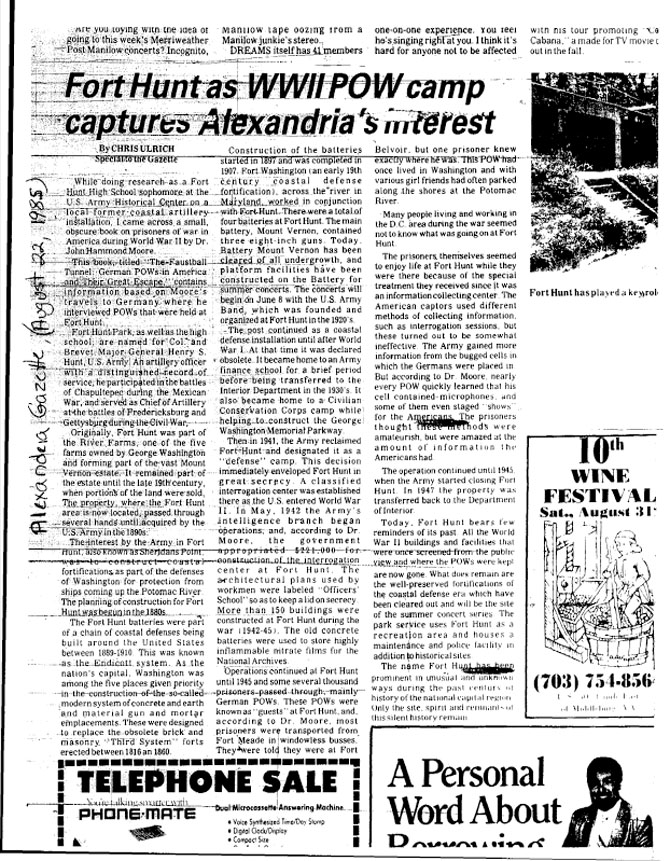 Looking Back at History
Looking Back at History
Originally published on Aug. 22, 1985 in the Alexandria Gazette Packet
While doing research as a Fort Hunt High School sophomore at the U.S. Army Historical Center on a local former coastal artillery installation, I came across a small obscure book on prisoners of war in America during World War II by Dr. John Hammond Moore.
This book, titled “The Faustball Tunnel: German POWs in America and Their Great Escape,” contains information based on Moore’s travels to Germany where he interviewed [prisoners] that were held at Fort Hunt.
Fort Hunt Park, as well as the high school, are named for Colonel and Brevet Major General Henry S. Hunt, U.S. Army. An artillery officer with a distinguished record of service, he participated in the battles of Chapultepec during the Mexican War, and served as Chief of Artillery at the battles of Fredericksburg and Gettysburg during the Civil War.
Originally, Fort Hunt was part of the River Farms, one of the five farms owned by George Washington and forming part of the vast Mount Vernon estate. It remained part of the estate until the late 19th century, when portions of the land were sold. The property, where the Fort Hunt area is now located, passed through several hands until acquired by the U.S. Army in the 1890s.
The interest by the Army in Fort Hunt, also known as Sheridans Point, was to construct coastal fortifications as part of the defenses of Washington for protection from ships coming up the Potomac River. The planning of construction for Fort Hunt was begun in the 1880s.
The Fort Hunt batteries were part of a chain of coastal defenses being built around the United States between 1889-1910. This was known as the Endicott System. As the nation’s capital, Washington was among the five places given priority in the construction of the so-called modern system of concrete and earth and material gun and mortar emplacements. These were designed to replace the obsolete brick and masonry “Third System” forts erected between 1816 and 1860.
Construction of the batteries started in 1897 and was completed in 1907. Fort Washington (an early 19th century coastal defense fortification), across the river in Maryland, worked in conjunction with Fort Hunt. There were a total of four batteries at Fort Hunt. The main battery, Mount Vernon, contained three eight-inch guns. Today, Battery Mount Vernon has been cleared of all undergrowth, and platform facilities have been constructed on the Battery for summer concerts. The concerts will begin on June 8 [1985] with the U.S. Army Bank, which was founded and organized at Fort Hunt in the 1920s.
The army post continued as a coastal defense installation until after World War One. At that time it was declared obsolete. It became home to an Army finance school for a brief period before being transferred to the U.S. Department of Interior in the 1930s. It also became home to a Civilian Conservation Corps camp while helping to construct the George Washington Memorial Parkway.
Then in 1941, the Army reclaimed Fort Hunt and designated it as a “defense” camp. This decision immediately enveloped Fort Hunt in great secrecy. A classified interrogation center was established there as the U.S. entered World War II. The activities at Fort Hunt were hidden and was known only by its mailing address as P.O. Box 1142. In May 1942, the Army’s intelligence branch began operations, and according to Dr. Moore, the government appropriated $221,000 for construction of the interrogation center at Fort Hunt. The architectural plans used by workmen were labeled “Officers School” so as to keep a lid on secrecy. More than 150 buildings were constructed at Fort Hunt during the war (1942-1945). The old concrete batteries were used to store highly inflammable nitrate films for the National Archives.
Operations continued at Fort Hunt until 1945 and some several thousand prisoners passed through Fort Hunt, mainly German POWs. These POWs were known as “guests” at Fort Hunt, and, according to Dr. Moore, most prisoners were transported from Fort Meade in windowless busses. They were told they were at Fort Belvoir, but one prisoner knew exactly where he was. This POW had once lived in Washington and with various girlfriends had often parked along the shores at the Potomac River.
Many people living and working in the Washington, DC area during the war seemed not to know what was going on at Fort Hunt.
The prisoners themselves seemed to enjoy life at Fort Hunt while they were there because of the special treatment they received since it was an information collecting center. The American captors used different methods of collecting information, such as interrogation sessions, but these turned out to be somewhat ineffective. The Army gained more information from the bugged cells in which the Germans were placed. But according to Dr. Moore, nearly every POW quickly learned that his cell contained microphones and some of them even staged “shows” for the Americans. The prisoners thought these methods were amateurish, but were amazed at the amount of information the Americans had.
The operation continued until 1945, when the Army started closing Fort Hunt. In 1947, the property was transferred back to the Department of Interior.
Today, Fort Hunt bears few reminders of its past. All the World War II buildings and facilities that were once screened from the public view and where the POWs were kept are now gone. What does remain are the well-preserved fortifications of the coastal defense era which have been cleared out and will be the site of the summer concert series. The park uses Fort Hunt as a recreation area and houses a maintenance and police facility in addition to historical sites.
The name Fort Hunt has been prominent in unusual and unknown ways during the past century of history of the national capital region. Only the site, spirit and remnants of this silent history remain.